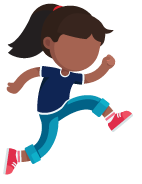Practical support for identifying and meeting need
Physical and sensory
What are sensory needs?
We all process and interpret information received from the environment and from within our bodies. This information gives us a sense of who we are, where we are and what is happening around us.
Our senses are: sight, hearing, touch, taste, smell, proprioception (body awareness), vestibular (balance and movement) and our interoception sense (internal body sense).
When our senses are integrating correctly we are able to respond appropriately to any sensation, for example, we are able to take off an itchy jumper or take a deep breath to smell the flowers, notice when we are hungry or need to use the bathroom.
What happens when a child or young person experiences sensory processing differently?
A young person may have difficulty working out what is happening inside and outside of their bodies. The sensory information may not be accurate, for example:
- the noise of the school bell is like someone screaming in their ear
- a piece of artwork on the wall keeps grabbing their attention because their brain hasn’t registered they have seen it before
- standing in the queue at lunchtime makes them on “high alert” in case someone brushes past them, which can be painful
- getting changed for PE is very difficult because of poor balance and not knowing where their hands are to put their jumper on when they can’t see their hands.
A young person may move constantly to get extra feedback if their body is not providing enough information as to where their arms and legs are. This is difficult in the classroom when they need to keep still and write. Most people get used to their own sensory preferences and can make choices about their daily activities appropriate for them. Some people don’t like the feel of polystyrene, some prefer quieter pubs and restaurants, some crave theme parks. However, children may struggle to communicate how they feel. They may feel insecure or be disorganised in a world they cannot make sense of. These children need support from those around them to learn strategies to make life a little easier.
There are some excellent resources on sensory needs on the NHS Greater Glasgow and Clyde website:
How to spot children with these needs in the school setting
Research shows that 20% of the school age population have sensory processing difficulties that impact on their ability to do every day activities.
You don’t have to have a diagnosis of cerebral palsy, ADHD, or autism to have sensory processing difficulties, although they are more recognised with these diagnoses.
Often we see children not achieving because they are struggling with sensory processing and then they can be thought of as showing challenging behaviour or low motivation and engagement.
If you suspect a student is struggling with the daily challenges of their school environment you can use this teacher observation checklist:
Practical ideas and strategies
Behaviours you might see in the classroom and sensory strategies to try.
You can find links to useful websites and documents at the bottom of the page >
Very physically active, fidgeting in chair, keeps getting up
- Try movement breaks scheduled into the daily timetable, especially 5–10 minutes before needing to focus on a task. These can include getting up to hand out books, taking a message, moving workstations, classroom tasks.
- Use of a wedge cushion, wobble cushion or Move ‘n’ Sit cushion.
Tips for using Move ‘n’ Sit cushions in the classroom >
Tips for using wedge cushions and wobble cushions > - Introduce whole class movement breaks
Opts out of/struggles with PE, especially with ball games
- Limit number of students and space to increase their sense of security.
- Modify PE lessons to:
- encourage balance activities to help organise their body as they move. May have to start with a line on the ground, walk on uneven surfaces etc and gradually progress to more challenging equipment (climbing, benches).
- encourage rolling activities, (grassy hill, use of large therapy ball)
- modified PE lessons:
Sensory Circuits: A sensory motor skills programme for children by Jane Horwood
Adjustments for PE for those with Dyspraxia/DCD by Dyspraxia Foundation
Difficulty standing in a line, may become silly or aggressive to peers
- Position at the front or rear of line to minimise chance of accidental touch by peers.
- Consider student holding the door open for peers.
Avoids/dislikes art and craft sessions
- Modify art activity – use of tools rather than hands if possible (brush, small hammer).
- Have towel/water available for student for use as soon as activity finished.
- Be mindful that if a student is significantly tactile defensive certain textures can be very distressing, even painful, and they should not be pressured to engage.
Hates assembly, avoids, struggles to sit quietly
- Use of ear defenders/ear buds
- Consider where to sit student:
- Position at the end of a row, near to the exit, so the student can leave if the noise level becomes distressing.
- Position at the back of the room if the student needs support from the wall to sit (would fidget excessively if no support), and to minimise risk of touch by others (tactile defensive).
- Possible use of chair for support rather than sit on the floor.
Dislikes dining hall
- Use of ear defenders/ear buds
- Use of a quiet room to minimise sensory input (student may be sensitive to noise, visual stimuli, smell, tactile senses)
Difficulty remembering and following instructions
- Support verbal instructions with written or visual aids
- Break down instructions into simple straight forward, short sentences
- Allow student more time to respond
- Ask student to repeat back to you to check understanding
- Reduce auditory distractions as much as possible
- More ideas can be found on the speech and language page >
Poor focus and attention
- Allow regular movement breaks, Move ‘n’ Sit wedge cushion, fidget aids (for example, blue tac, stress ball) of their choice
to allow student to meet their sensory needs and organize themselves in readiness for learning - Limit visual distractions within the classroom (wall displays)
- Limit auditory distractions wherever possible
- Position in class to limit risk of accidental touch by peers
Behaves erratically when changing classrooms
- Allow student to leave few minutes earlier to reduce the risk of sensory overload by limiting visual, auditory and potential tactile input.
- Student may have difficulty negotiating stairs, needing to look at their feet and hold onto a handrail (problems with proprioceptive and vestibular processing). Safety risk during transition times.
Frequently chews on clothing, pencils
- Use of chewy aids such as Chewlry pencil toppers should be available at all times to avoid student chewing inappropriate objects.
- Regular movement breaks. Chewing can be an attempt to seek proprioceptive input (heavy muscle work through the jaw).
Often bumps into people/furniture
- Build regular movement breaks into the daily timetable. This can include chair/wall push ups
Struggles with handwriting, puts too much/too little pressure through pencil
- Regular movement breaks
- Hand exercises prior to writing task to prime the muscles of the hands. Activities can include play dough, Theraputty (for older students).
- Encourage squeezing, stretching activities
Difficulty copying from the whiteboard
- Position at front of the class to limit visual distractions
- Provide written sheet on the desk rather than student copy form board
- Use of angled writing surface to reduce the distance the eyes have to travel from the board to the paper
Very disorganised, difficulty retaining information, problems with dressing (forgetting the order, back – front, inside out), student is very slow at changing
- Encourage use of visual reminders/checklist
- Allow extra time for changing PE or allow student to change partially
- Provide student with a bench to sit on to make balance and coordination easier
- Provide a low stimuli environment, away from peers, to limit distractions (visual, auditory, tactile)
Toileting accidents – some students do not know when they need the bathroom if their internal body sense is poor (interoception)
- Use of timers, a visual timeline, to act as a reminder
- Vibrating watch alarms can be useful and discreet
Specialist – additional support for children and young people with an ongoing and significant identified need
Learning environment
- Consistency and predictability is provided wherever possible – with changes and transitions planned well in advance
- Use of additional visual support e.g. signs and symbols, choice boards
- Social stories are used to explain expectations and ways of dealing with situations
- The learning environment is kept as free as possible from sensory experiences the child might find difficult e.g. Visual clutter on walls, loud noises, strong smells, with warning given if unavoidable, for example, fire alarm practice.
- Check whether the child needs adaptations to seating and equipment e.g. pen grips, sloping board, move n sit cushion, to feel comfortable. Find out more about sensory equipment > (Sensory Direct website)
Access to the curriculum
- A sensory profile completed by one of the specialist services supporting the child with recommended sensory strategies for in and out of the classroom setting.
- A highly differentiated / modified curriculum which takes into account the individual’s sensory needs as well as needs in other areas
- Additional adult support may be required in the classroom – to help the child stay calm and focus and to recover if they have become distressed. This may need a designated area for calming strategies to be implemented.




